Are you ready to make one of the most versatile staple recipes to stock your cannabis kitchen? This easy, step-by-step beginner’s guide will teach you how to make cannabis coconut oil at home in a crockpot, Instant pot, or stove. It is perfect for anyone who wants to learn how to make a cannabis-infused oil that is vegan, dairy-free, and versatile enough to be used as a base for recipes and self-care products.
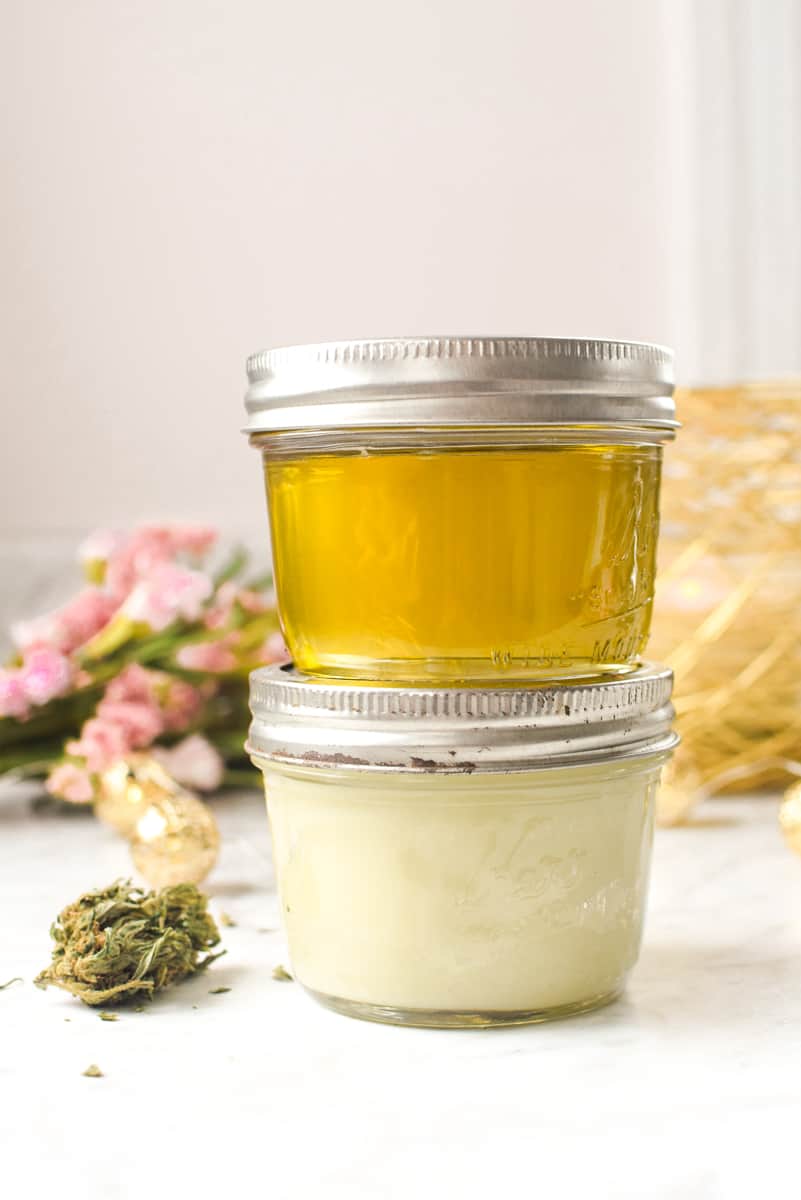
Table of Contents
- Article Features
- Why You Will Love This Recipe
- What You’ll Need
- The Step-by-Step Process
- Storage Instructions
- Why Coconut Oil Is Great For Infusions
- Don’t Forget To Decarb
- Additional Factors to Consider
- Notes & Expert Tips
- Easy Crockpot Cannabis Coconut Oil Recipe
- Frequently Asked Questions
- Recipes To Make With Coconut Oil
Article Features
- A fan favorite with over 1,100+ happy reviews!
- Just two ingredients needed – cannabis flower & coconut oil
- Want to make it easy? Skip the hard work, order my Bliss MCT Oil, and have it delivered straight to your door – now shipping across the United States!
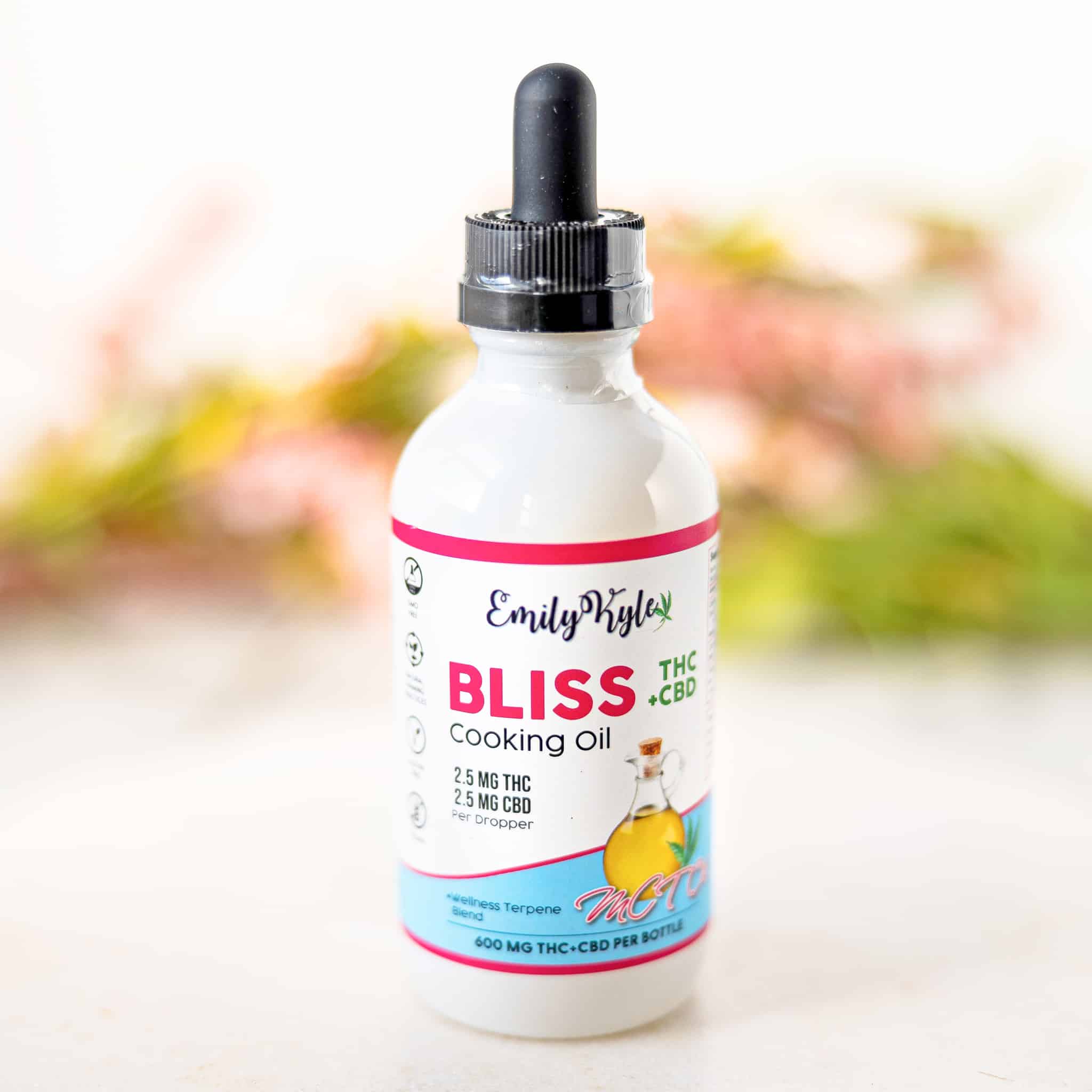
Why You Will Love This Recipe
Hello and welcome, fellow cannabis connoisseur – I hope you are as excited as I am to make this incredible staple recipe today.
I surveyed members of my Well With Cannabis Community, and this recipe was #2 in the most popular infusion category, next only to cannabutter.
It’s no wonder everyone loves cannabis coconut oil; it is versatile and perfect to use in both edible and topical recipes.
It’s plant-based and works with nearly every diet.
The fat in the oil is perfect for pulling the cannabinoids from the plant matter and creating a potent infusion.
The final product is a cannabis-infused oil that can be used to make your favorite recipes like the ever-popular brownie, chocolate chip cookies, and more.
Here, you will find my ingredient recommendations, step-by-step instructions, expert tips and advice, and the free printable recipe card at the end of the post. Happy Infusing!
What You’ll Need
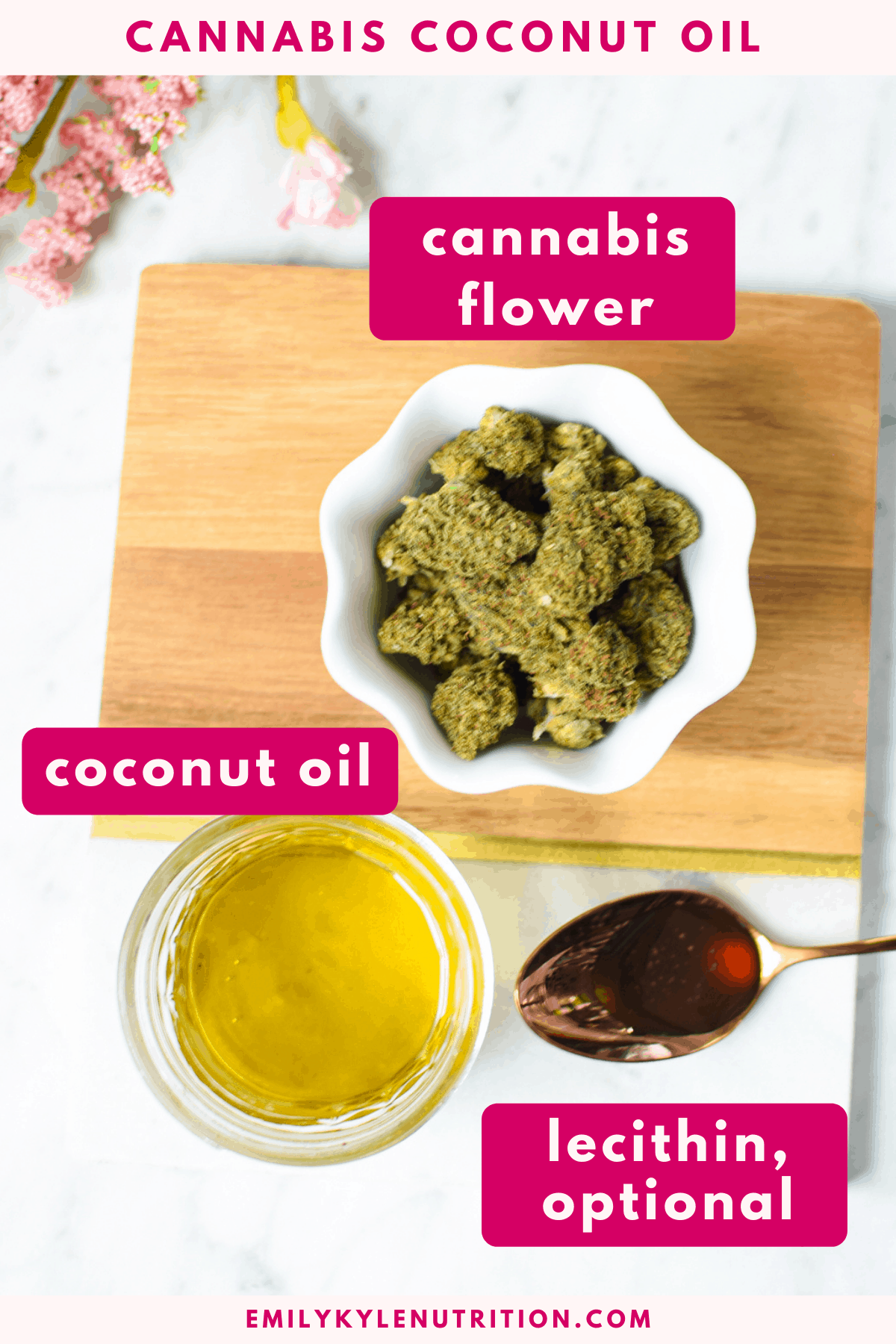
Note: Determine how much to use for each ingredient below with this flower-to-oil ratio guide.
- Coconut Oil – Further explained below, you can choose between refined and unrefined coconut oil.
- Cannabis flower – Your desired amount of cannabis flower, ranging from 3.5 grams up to 1 ounce. Choose THC flower, CBD flower, or CBG flower. You can purchase flowers from my online shop.
- Lecithin – This optional ingredient is a natural emulsifier that may help improve bioavailability. Learn more about adding lecithin to edibles here. You can purchase liquid or powdered lecithin online.
Note: A complete list of ingredients with amounts and instructions is located in the printable recipe card below.
The Step-by-Step Process
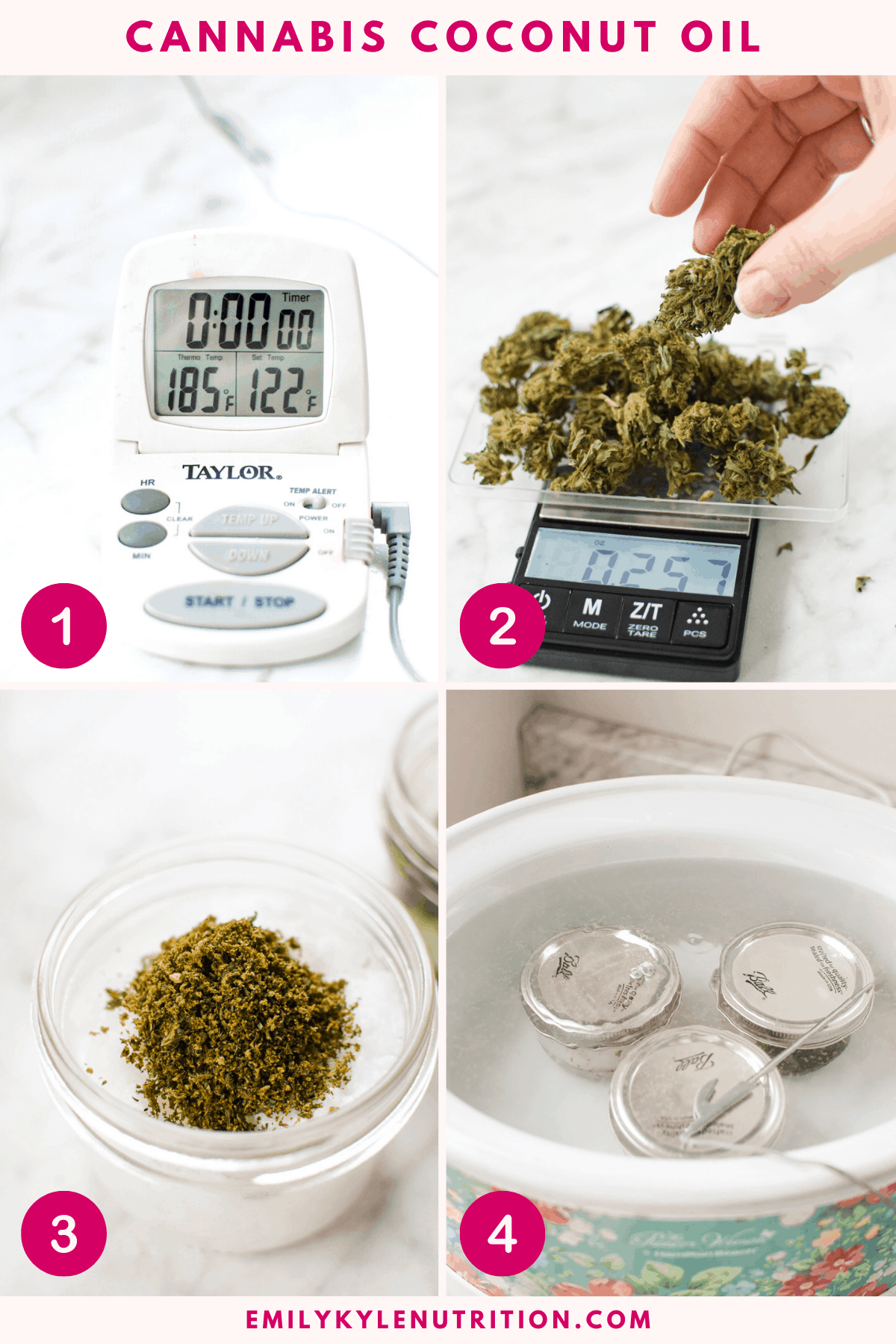
- Step 1 – You want to create a water bath that stays at approximately 180-190° F. The instructions below are for using a crockpot. Alternatively, here are instructions for using an Instant Pot or the stovetop.
- Step 2 – While heating the water bath, measure and decarb your cannabis flower. Use my oven or Instant Pot decarboxylation tutorials if needed. Remember, you do not want to grind the flower.
- Step 3 – Add the decarbed cannabis and coconut oil to a mason jar. If you plan on using lecithin, add it to the jars now. Secure the lid on the jar.
- Step 4 – Carefully place the jars in the water bath. Place the lid on the crockpot. Leave it alone to infuse for 4 hours. After 4 hours, remove the jars from the water to cool.
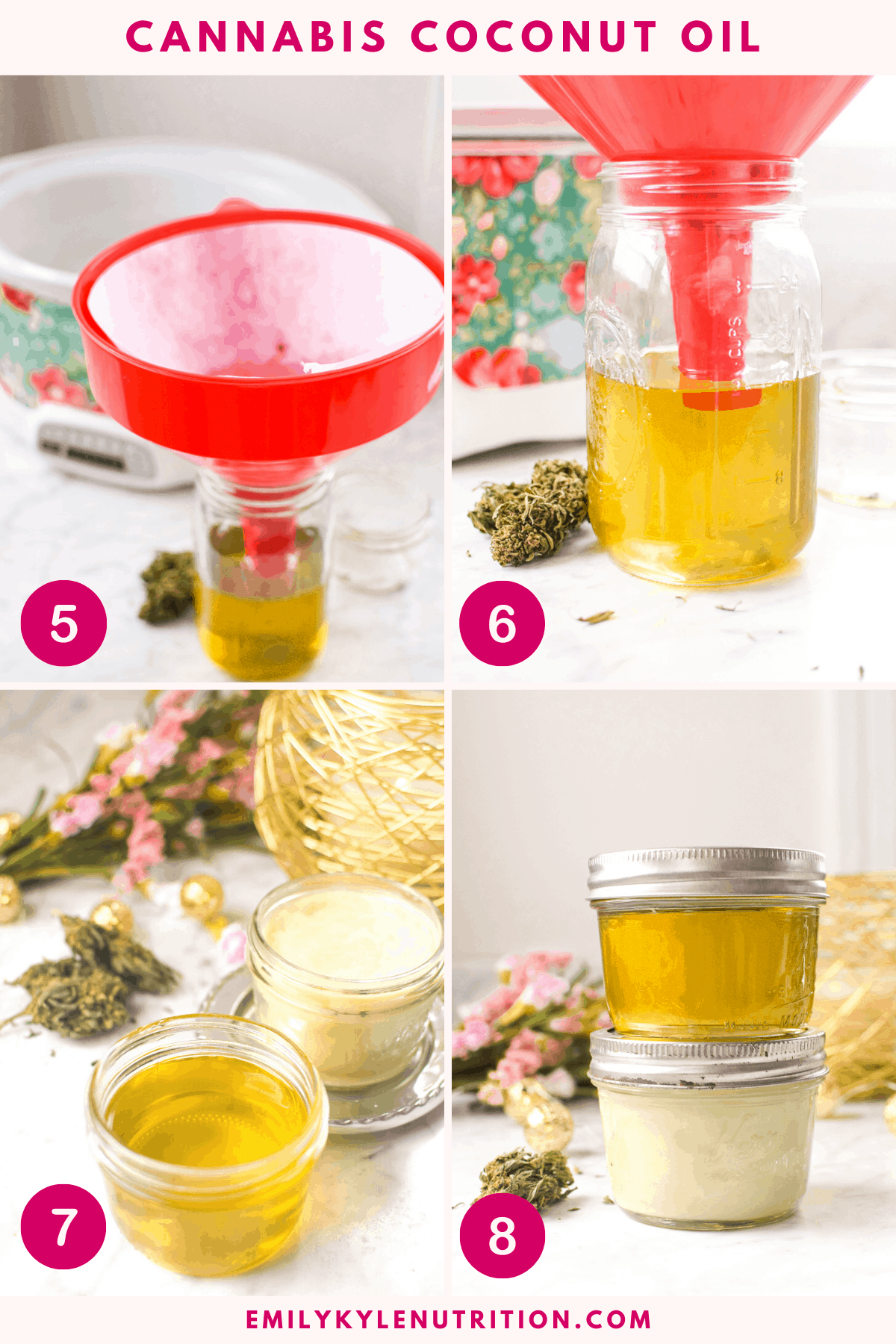
- Step 5 – Whether it be a paper filter and funnel, cheesecloth, French press, or a simple coffee filter, you will want to set up a straining station to separate the plant matter from the oil.
- Step 6 – Strain the prepared oil. You can save the leftover cannabis pulp for use in future recipes.
- Step 7 – Return the prepared oil to whatever jar you would like to store it in; a mason jar works well.
- Step 8 – Store the prepared cannabis coconut oil in a cool, dry place.
Note: Complete step-by-step printable instructions are located in the recipe card below.
Storage Instructions
Store your prepared oil in a cool, dry place. It will last longer if stored in the refrigerator and even longer if stored in the freezer.
Keep the jar out of direct sunlight, and keep it in a cool, dark cupboard or even the refrigerator.
If you store coconut oil in the refrigerator, know that it will solidify into a solid mass. This is normal.
However, in order to get it back to a workable state, you will need to let it sit out to soften. Never use the microwave to warm cannabis infusions.
Learn more about how to store cannabis edibles, specifically CBD oil.
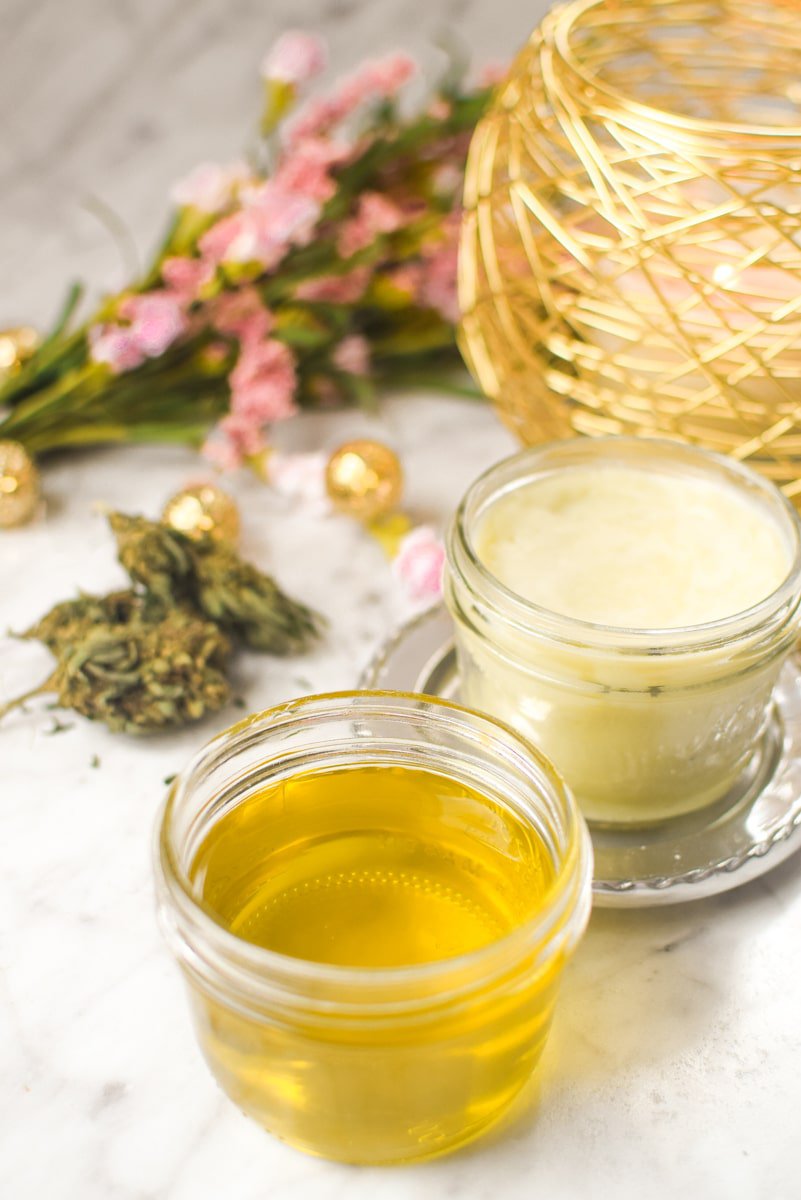
Why Coconut Oil Is Great For Infusions
I help educate my Cannabis Compass Online Course students about how they can learn to confidently use cannabis to improve their quality of life.
Many of my students follow a gluten-free and dairy-free diet, which is why I wanted a cannabis-infused butter alternative that was dairy-free.
Coconut oil is the perfect substitute for butter when in need of dairy-free or vegan cannabutter.
The coconut oil performs similarly to the butter in extracting the cannabinoids from the plant matter, and it remains solid at room temperature like butter.
Coconut oil is naturally dairy-free, vegan, vegetarian, plant-based, and allergen-friendly, and this is the product I use and recommend when making our own at home.
This cannabis-infused coconut oil is a great option for anyone following a specialty diet or just looking for an alternative to traditional cannabutter.
Choose A Type of Coconut Oil
There are many different types of coconut oil on the market today, the three most common being unrefined coconut oil, refined coconut oil, and MCT oil.
It is ultimately your decision on which type of oil you want to infuse, but here are some important considerations when making your decision.
Virgin or Unrefined Coconut Oil
Virgin or unrefined coconut oil is about as close to the natural substance as you can get.
Unrefined coconut oil is made from the ‘meat’ of fresh coconuts and then cold-pressed, leaving just the oil which has a pure coconut flavor.
Unrefined coconut oil has a more natural, more prominent, topical coconut taste and smell.
Like refined coconut oil, unrefined coconut oil is 63% MCTs and 50% lauric acid, meaning it infuses the same.
If you choose to use unrefined coconut oil, this is the organic virgin unrefined coconut oil I recommend.
Refined Coconut Oil
Refined coconut oil is an oil made from dried coconuts that have been put through additional processing.
Some companies use harsh chemicals to bleach the coconut to remove the taste and flavor, while others use steam to refine the oil.
The biggest draw to refined coconut oil is that it has a very neutral taste and flavor, making it easier to work within certain recipes where the coconut taste is not wanted.
Many people prefer refined coconut oil because it has a less prominent coconut taste. Like unrefined coconut oil, refined coconut oil is 63% MCTs and 50% lauric acid, meaning it infuses the same.
If you choose refined coconut oil, you will always want to make sure you choose a sustainably farmed organic steam refined coconut oil like this one I recommend.
SAVE THIS GUIDE 💌
MCT Coconut Oil
MCT oil is a type of saturated fat extracted from coconuts that are rapidly digested and absorbed by the body.
Many people prefer liquid MCT oil for infusions because it is tasteless and remains liquid at room temperature.
The process for infusing MCT oil is the same as refined or unrefined coconut oil, although I do have a specific guide for making an MCT oil infusion here.
One important thing to note is that MCT oil in large amounts may cause digestive distress in some individuals.
If you choose to use type oil, this is the MCT oil product I recommend.
Don’t Forget To Decarb
Before getting started, it is important to note that consuming dried or raw cannabis flower buds will provide little to no intoxicating effect at all.
If you do not decarboxylate, you will reap the health benefits of CBDA or THCA, which are non-intoxicating.
However, most people want to feel the full effects of activated CBD or THC flower when making edibles.
For this recipe, I decarboxylated the cannabis flower in the oven before combining it with coconut oil and placing it into the crockpot. Therefore, we have a shorter cooking time, about four hours.
You can also decarb in an Instant Pot, if you have one.
If You Forget to Decarb
While I recommend going through the full decarb process for maximum benefits, truthfully, if you accidentally skip the decarboxylation process, we can fix it.
You will simply increase your infusion time which will help you achieve decarboxylation over time.
If you don’t decarb first, I recommend infusing the coconut oil for longer than the typical 4 hours, going for at least 8-12 hours.
This longer cooking time helps to decarboxylate the flower for you. If you accidentally forget to decarb, you can relax, all is not lost.
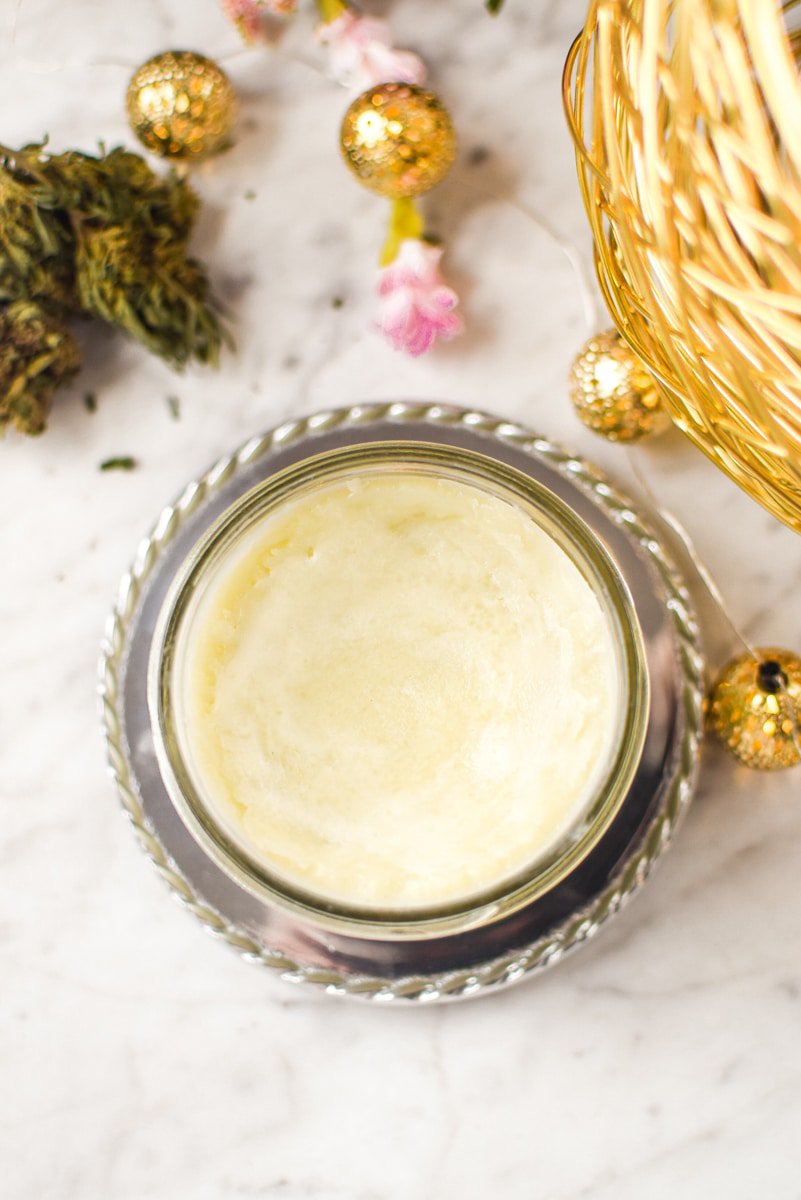
Additional Factors to Consider
If you asked 100 different Chefs, you would likely get 100 different variations on how to make your own cannabis-infused oil at home.
In addition to different techniques, many other factors can affect your results when cooking with cannabis.
Here are a few additional considerations to keep in mind.
Temperature Controls
It is important to keep tight temperature controls when cooking with cannabis.
While heat is needed to decarboxylate the acids into the active form of cannabinoids our bodies can use, extreme temperatures can destroy many important plant materials that contribute to positive health outcomes, like terpenes.
Each terpene may have its own therapeutic health benefits, but it also carries its own sensitivity to heat.
If cannabis is heated above 300° Fahrenheit for a prolonged period of time, you run the risk of denaturing many important plant compounds.
For this reason, I recommend using an instant digital-read thermometer during your cooking process to ensure you never go above the safe temperature threshold.
You may also want to invest in a machine that can decarboxylate and infuse for you, like the Ardent or LEVO infusion machines.
The Strain of Cannabis Used
The strain of cannabis flower you are using will impact decarboxylation time and temperature recommendations.
Each cannabis strain contains varying amounts and ratios of different cannabinoids and terpenes.
Because each cannabinoid and terpene decarboxylates at a different temperature, you will want to consider the best temperature and cooking time for your particular strain.
Additionally, the final potency and intoxicating effects will vary depending on whether it is a THC or CBD-dominant strain.
There are CBD dominant flower options and THC dominant cannabis flower options to choose from.
The Freshness of Product
You will have noticeable differences in the final product depending on the freshness of the material you start with.
Cannabis coconut oil can be made with raw cannabis leaf trimmings to make a CBDA or THCA dominant oil and it can also be made with traditionally dried and cured flower buds.
The concentration of cannabinoids will vary with the freshness of the starting material, the cannabinoid concentration of the material, which will ultimately impact your final product’s potency.
Equipment Variability
You can make cannabis coconut oil with various pieces of equipment like a crockpot or slow cooker or Instant Pot, but small variables in the cooking equipment may impact your final product.
Different crockpots will have different temperatures when setting to the same setting, which is why I recommend a digital thermometer be used throughout the cooking process.
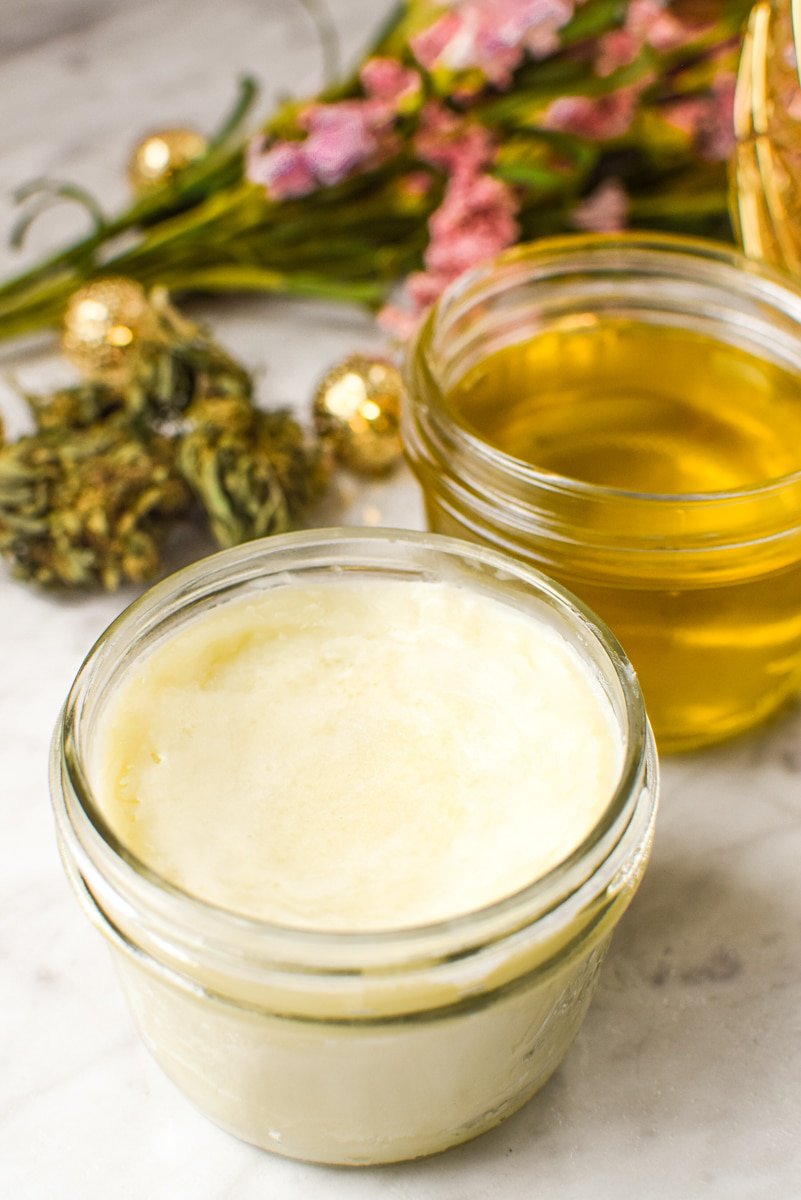
Notes & Expert Tips
- Sometimes the mason jar will float when placed in the water bath. This is no need for concern, simply put something heat and water safe over the top of the jar to weigh it down, a clean rock works well.
- Don’t love coconut oil? You can use this process with any oil. Alternative carrier oil options include: avocado oil, hemp seed oil, grapeseed oil or MCT oil
- Cannabis coconut oil can serve as a vegan cannabutter alternative and is an important for any cannabis consumer to master alongside cannabis olive oil.
- Making infused cannabis coconut oil is a fairly straightforward process that uses both heat and fat to decarboxylate the cannabis flower and extract the cannabinoids from the plant.
- This process extracts a full spectrum of cannabinoids and other plant compounds from the plant.
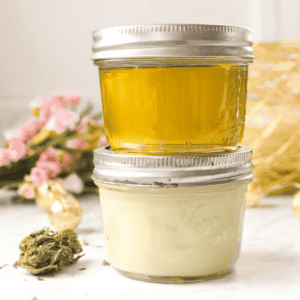
Easy Crockpot Cannabis Coconut Oil
Ingredients
- 1 ounce cannabis flower pre-decarb
- 16 ounces coconut oil
- 1 teaspoon liquid sunflower lecithin optional
Instructions
- Lay a clean tea towel down on the bottom of your crockpot. This will create a buffer between your mason jars and the crockpot, potentially preventing any jar from moving or cracking during cooking.
- Fill your crockpot with enough warm to hot water to cover the top of the mason jars you plan on using by an inch to create a water bath.
- Place the digital instant-read thermometer into the water. Start the crockpot heat on high. When a temperature of 185° F is reached, turn the crockpot to low.
- While the water bath is heating in the crockpot, measure and decarb the cannabis flower in the oven at 240°F for 40 minutes (for THC-flower). Click here for a full cannabis decarboxylation tutorial, if needed.
- Evenly divide the coconut oil between the mason jars you plan on using. You can either use pint-sized or half-pint-sized jars, it's you're preference, just be sure they fit in your crockpot. No matter the size, be sure to leave a 1/2 inch headspace from the top.
- If you plan on using sunflower lecithin, add it to the mason jars now.
- Evenly divide the decarbed flower between the coconut oil-filled jars. Wipe the rim of the jars with a clean paper towel and place the lid on. Tighten the metal ring to finger-tip tightness, it does not have to be tightened all the way. Do not tighten too tightly.
- Once the water bath reaches a temperature of 185° F, carefully place the jars into the water bath. Place the lid on the crockpot and leave alone to infuse for 4 hours.
- After 4 hours, carefully remove the lid, followed by the jars from the hot water. Set them aside to cool.
- Once cool enough to handle, you will want to strain the cannabis oil through a paper filter and funnel, cheesecloth, or French press to separate the plant-matter from the coconut oil.
- Save the leftover cannabis pulp for use in future recipes. Then return the prepared cannabis coconut oil to whatever jar you would like to store it in. We use a mason jar.
- Store the prepared cannabis coconut oil in a cool, dry place. It will last longer if stored in the refrigerator and even longer if stored in the freezer.
Video
Notes
Nutrition
Frequently Asked Questions
In theory, using lecithin will make valuable cannabinoids like CBD and THC more bioavailable or ready for use by the body, ultimately making the edible stronger. You will definitely still have a great infused cannabis oil if you don’t use lecithin, it’s not a make or break ingredient for this recipe.
Yes, you can infuse coconut oil with full-extract cannabis oil, FECO (or RSO), instead of flowers. If you want to infuse with this type of oil, here is my guide on making FECO.
After the straining process to separate the plant matter from your infused oil, you will be leftover with a ball of spent cannabis flower, also called leftover pulp or sludge.
Yes, just use the cannabis flower to oil ratio chart below to choose the batch size that is right for you.
Recipes To Make With Coconut Oil
Cannabis Dessert Recipes
Easy Cannabis Brownies Recipe
Cannabis Topicals
Easy Homemade Cannabis Salve Recipe
Cannabis Drink Recipes
Creamy Cannabis Hot Chocolate
Cannabis Dessert Recipes
Quick & Easy Cannabis Chocolates


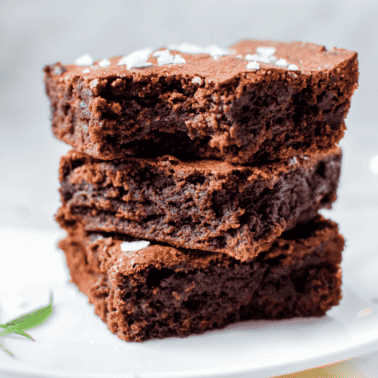
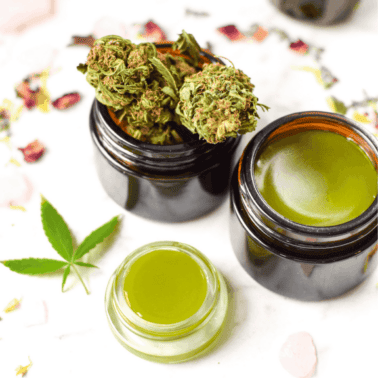
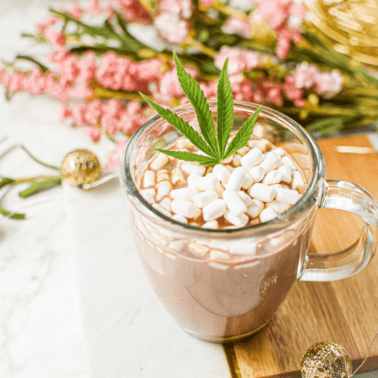
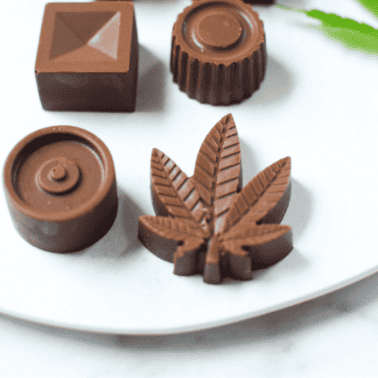









What do I do AFTER I decarb the flower, how do I extract the THC?
Hi, Charles, after you decarb the flower, you will combine it with the coconut oil in a jar and proceed with infusing them together with the help of the water bath. The infusion process outlined here is what extracts the THC from the plant matter and into the oil. It’s important to maintain a consistent low heat during the water bath to ensure efficient extraction without burning or degrading the cannabinoids. Once the infusion is complete, you’ll strain the oil through a fine mesh or cheesecloth to remove any plant material, leaving you with a smooth, THC-infused coconut oil ready for use.
If I want to infuse liquid coconut oil to add to my gummy mix do you recommend the 2cups liquid coconut oil and 1oz flower recipe in the crockpot?
Hi Robin. The 2 cups of liquid coconut oil to 1 oz of flower recipe in the crockpot is a popular choice and works well for infusing oil and it should work great for your gummy mix. Enjoy!
Hello. Thanks so much for all the info on this site; very helpful. I do have a question about this recipe; if using a double boiler method for infusion of cannabis oil, assuming I decarb first, is 4 hours necessary for maximum infusion? I usually only do 2 hours (not counting the 40 min decarb), and I am pleased with how it turns out, but if it will be more potent with a longer time, then I will certainly start. What is your opinion, if you don’t mind me asking?
Hi Kyra! I’m really glad you’re finding the information here helpful. It’s great you’ve had success with a 2-hour infusion time. Generally, the 4-hour recommendation is aimed at achieving maximum potency, but if you’re pleased with the results from a 2-hour infusion, you might already be hitting the sweet spot for your needs. The extra time can indeed increase potency, but it’s also about finding the right balance for your personal preference. If you’re curious, it could be worth experimenting with a longer infusion time on a small batch to see if you notice a significant difference. Remember, it’s all about what works best for you!
Do the jars have to be completely covered in water?
Yes Inez, it’s important to ensure that the jars are completely submerged in water. This helps to maintain an even temperature around the jar, ensuring your infusion process is consistent.
How do you get the oil so clear and golden? Mine turned out dark greenish brown.
Hi Deb. The color is dependent on a few things, but has a lot to do with the cannabis flower itself that is used. Some Well With Cannabis community members like to wash their cannabis before infusing to help with the final color and taste of their infusion.
Soak your cannabis bud for 2-3 days with distilled water in a french press. The water will turn brown, dark gold, green, clear or cloudy and should be changed every 12 hours. After 2-3 days the water should run clear. You’ll need boiling water and a bowl of ice water for the next step.
Once clear, transfer the cannabis to a tea strainer and boil for 5 minutes before removing and placing in ice water for one minute. The next step would be to dry the bud before moving forward with the edibles process. I prefer to air dry personally, but many members have used salad spinners to spin out the excess water. Once dry, you can decarb and use in your edibles for a light-tasting final product.
I just want to note that when you wash away the chlorophyll and impurities, you are also washing away the terpenes and flavonoids. For some that is no big deal, but for others, it can be a deal breaker.
I hope this information helps!
Can you use an Instapot for this recipe? If so how would you modify settings?
Hi Erika. You can use an Instant Pot, but you would want to use the Slow Cook option for infusion and run for 4 hours. Here is a guide and recipe to walk you through it: Instant Pot Cannabutter or Oil » Easy Guide. I hope this heps!
Hello Emily! I love your website! It has so much great and easy to follow information! I am a new grower and have a lot of trim (sugar leaf and some small buds that were sifted from my trimming bowl) as well as kief that I sifted from the trim also. I want to make gummies with the trim and maybe add a little kief to add to potiency. I’m trying to figure out the strength since some of the trim is small buds. Do you have any suggestions on this as well as how much kief I should add? Thank you so much for this great website!! Wendy Jane
Hi Wendy Jane! I’m thrilled to hear that you’re finding the website helpful and are diving into the world of growing your own! 🌿 When it comes to making gummies with trim and kief, potency can vary A LOT. As a starting point, I’d suggest using a little less kief than you think you might need, then adjust based on the results. Remember, it’s easier to add more potency, but you can’t take it away once it’s in there! Good luck!
I tried this recipe for the first time and my husband and I love it! I then also tried to make gummies using your recipe and they turned out just as good. I did add flavoring to the gummy mix & next time I plan on adding more flaoring. I was thinking I might have done something wrong because the gummies seemed to be sweating alot. I left them out a day or 2 longer for drying & they seemed to be fine. I am definitely going to be making more of these & I plan to try more of your recipes!! 🙌🫶
Hi Stephanie. Thank you so much for your comment. We’re thrilled to hear that you loved the recipe and that your gummies turned out great too. Have fun exploring our other recipes. Enjoy your cooking adventures!
Hi Emily. I am using harlequin, which is a sativa strain. It has a 1 to 1 ratio. It is now the 1st week of October. My trichomes are mostly cloudy. What percentage of cloudy to amber trichomes should I be looking for for higher CBd? Also when decarbing in oven, what temperature and time should I be referring to for higher CBd. Also if you cut down the time frame, will you get a higher thc content? Thanks
Hi Danny. The trichome color dictates the overall cannabis experience you will have. Some prefer the uplifting effects of mostly clear trichomes while others prefer the more sedating effects from mostly amber trichomes. It all depends on what effects you are trying to achieve. When all trichomes are cloudy, they have reached their maximum THC levels, which means you’ll get the most psychoactive effects. As trichomes mature even further, they transition from cloudy to an amber color. This stage is associated with a higher presence of CBN. Harvesting at this stage can result in a more relaxing or “body” high.
To activate the CBD, you want to decarb for 90 minutes at 240º, which will also activate the THC. Happy Harvesting!
Can I make coconut oil / butter using decarbed cannabis?
Hi Ed. Absolutely! For many, decarbed cannabis is preferred. Happy infusing!
Is it ok to make with the lecithin??
Hi Becca. Absolutely! Lecithin is an optional ingredient is a natural emulsifier that may help improve bioavailability. Happy infusing!
Can you melt gummy bears and add coconut infused oil?
How much melted gummy to how much oil?
Hi Pattie. You can definitely melt gummy bears and add coconut infused oil to create your own infused gummies. A common suggestion is to melt store-bought gummy bears and mix in your desired amount of infused oil based on how strong you want the gummies. Experiment with small batches to find your preferred consistency and potency. Happy gummy-making!
Thank you so much for sharing recipes,I’ve been making several time and other sweets baking also,most easy method to make butter this way,always successful!!thank you!!
Hi Ruka. Thank you so much for your kind words and for sharing your positive experience with the recipes. We’re really glad that the method we shared has been helpful and easy for you. There’s nothing better than a foolproof technique that consistently yields great results.
Keep up the fantastic work, and happy baking!
Thank you for all the great info. I forgot to set temp alarm on my thermometer. It got up to 204 degrees on low somehow. Not sure how long. Is my oil ruined?
Hi Hubachi. No worries! While cannabinoids and terpenes can degrade at higher temperatures, the key ones like THC and CBD start showing degradation effects at much higher temperatures than 204ºF. THC doesn’t begin to evaporate until it reaches a temperature of around 315°F. Even if your thermometer reached 204º for a longer period of time, it’s unlikely that your oil is ruined. The bigger concern is that some terpenes, which contribute to the flavor and aroma of the oil, have lower boiling points, so some may have evaporated off.
Next time, you might want to check the temperature more frequently to prevent overheating, but for now, your oil should still be okay to use. Enjoy your cooking adventures!
I’ve followed your direction a couple times and it works great everyone loves my brownies. But I was wondering I’m going to make a gallon of coconut oil do I need to use the jars or can I just do the gallon in my slow cooker along with the he flower and then strain like normal. I just don’t want to mess up
Hi Pat. We’re thrilled to hear that you’ve had success with this recipe and that your brownies are a hit! You can absolutely infuse a larger amount of coconut oil directly in the slow cooker without using jars. The key is to ensure that the mixture doesn’t get too hot and stays consistent around 185º. Happy infusing!
Hi Emily. Currently making this for thc pills, thanks for the recipe ?
I have a question and it’s: should I grind the decarbed bud before infusion? My goal is simply to preserve as much thc as possible. Would grinding reduce the amount of thc due to the small pieces not being able to handle the 185° temperature, or would it increase the thc as the surface area would increase?
Thank you ?
Hi Joel. Grinding the bud can cause a significant loss of the trichomes, which could result in a lower overall potency of your infused product. Additionally, grinding the bud will release more chlorophyll and plant matter into your infusion, which could affect the taste and color of the final product, making it more “plant-like” and less desirable. ? We recommend breaking up the bud by hand into small pieces rather than grinding it. This method can still increase the surface area for better infusion while minimizing the loss of trichomes, reducing the amount of chlorophyll and plant matter released, and making the straining process easier.
Ultimately, the choice is yours though. I hope this helps!
For those who don’t like the smell when decarbing in the oven…..
I have an electric pressure cooker (InstaPot = IP) that works wonders. Place bud in an airtight container; place container on trivet. Add 1 cup water in (IP) inner liner. Close IP. Set to pressure cook for 20 minutes. Let cool competely before opening and removing airtight container. Voila!!! Decarbed weed, no smell.
Hi Laura. Thank you for sharing your process with our readers. ?
I am normally in the habit of grinding decarbed bub to a fine power & then straining out the debris. I’m left with what looks like green flour. I add this powder to melted chocolate to make chocolates. Can I use this powder when making cannabis coconut oil or should I stick with decarbed chunky bud?
Hi Laura. It is hard to strain kief (powdery cannabis) when using it to infuse the oil, so if you don’t mind the flower remaining in the oil, you can definitely use kief. If you want to be able to remove the flower for clean oil, then we recommend using popcorn-sized buds. ☺️
Hello Emily,
The rabbit hole of articles I’ve read have been very informative and I’m excited to attempt my first batch of edibles. I do have a few questions. I don’t see myself being able to decarb in my oven since I have three kids and a wife who wouldn’t be thrilled about the smell, so I’ll likely have to just extend the steeping time in the jars. I’ll also be using a sous vide circulator to keep my temperature 100% consistent. Do you know how much, if at all, the THC potency would be affected by doing this instead of a proper decarb? In regards to potency, is longer steeping time beyond 8 hours better, and if so, is there a point at which the increased time becomes detrimental to potency because of compounds breaking down? I’m not so concerned about over infusing chlorophyll and the extra “weedy” taste, I just want to get the most bang for my buck out of my product. Thank you so much for your articles, and I look forward to hearing back from you!
Hi David. Many members run their crockpot infusion for eight hours and claim the effects are the same as if the cannabis was decarbed first. Longer steeping time will provide a sleepier final product as the THC continues to convert into CBN the longer it is exposed to heat. We don’t recommend running infusions any longer than the eight hours that our community members recommend. Side note, you can use the sous vide method to decarb cannabis, and it helps reduce the strong odors. I hope this helps!
Hi Emily, thanks for your very informative website. I love all your recipes.
I have a question regarding the cannabis oil infusion, after i decarbed the flowers and then added the coconut oil, why am I losing around 70mL – 100mL cannabis oil output? I’m using cheese cloth to sieve after infusion.
Thanks so much in advance.
Hi Aprelle. You will always lose some oil when infusing with cannabis and for some reason, the volume loss seems to be higher when infusing less. I always start with at least 1/4 cup more than what I hope to get back. For instance, if I want one cup of cannabis-infused oil, I will start my infusion with 1 1/4 cups. Make sense?
What can you do with the leftover cannabis from the infused oil?
Hi Deborah. There are a few options. Check out this article:15 Best Ways To Use Leftover Cannabis Pulp
Hi, followed this recipe last year and it was pretty good to have around. I’ve been keeping it in a jar in the fridge since September 22’. My question is what’s the shelf life? And do you have any insight? Almost over night my oil got a strong chemical smell to it. The smell is familiar but I can’t place it. I don’t see any mold. For reference I’ve had it for about 7-8 months in fridge. I don’t have a ton left, but there’s def more than I’d prefer to throw out. Any thoughts would be helpful. Thanks!
Hi Joj. If it smells sour or bitter, then the oil is bad. If stored properly, cannabis-infused coconut oil has a shelf life of 2-3 months stored at room temperature, and up to three years if stored in the fridge. It’s important that the jar is airtight and sealed properly. A marbled appearance, black spots, and bumpy or grainy texture are all indications to throw away your coconut oil. I hope this helps!
Can you use half pint jars instead if pints? Also can you use a kitchen towel or cloth napkin for bottom of slow cooker?
Hi Lindsey. Yes to both questions. Half pint jars work well and a kitchen towel or cloth napkin will suffice. Cheers to Cooking with Cannabis! ?
If top of lid is exposed will it effect or I s it dangerous ?
Hi Steve. The top exposed is fine as long as the contents of the jar are covered by the water line.
Is it possible to combine the flower and coconut oil directly to the crock pot and simmer on low thereby skipping the jars altogether, initially? Seems like an unnecessary step but maybe I am missing something
Hi Cathy. You can definitely infuse directly in the crockpot. We recommend using mason jars for two reasons. Mason jars greatly reduce the cannabis odor in the air and you can use the same jar for decarb, infusing and storing which reduces the amount of cleanup overall. I hope this helps!
I’m so happily surprised with how good my oil came out this time! First time trying this recipe to make infused oil too. I followed the directions carefully aswell to ensure that it would come out I was a bit nervous being my first time using this method but I’m not switching back, the potency of my oil is amazing! My next step is trying my hand at the gummy’s! I’ll update once I’ve made them! Thank you for having such simple instructions!!!
Harley, I am so happy to hear about your success! I hope the gummies turn out just as good. Enjoy 😀
Love your website and all the very helpful information. I don’t have a crockpot. Is there a stovetop method I can follow? And what happens if the oil gets too hot during the infusion process?
Hello Scott! Yes, of course, I have a stovetop method guide right here. Just swap the butter for coconut oil. This method uses a water bath, so no worries that the oil will ever get too hot. Good luck 😀
Dear Emily:
We used your recipe for 1:1 Cannabis flower to oil ratio chart resulting in infused oil that is twice as potent, so are we correct in assuming that we are to half the amount of oil to be used in all of your recipes? Also, how long can we keep gummies once made? Can they be kept for months if frozen?
Hello Kim! This will totally depend on how strong you want your final product. If you want a very strong end product, use the full amount. If you don’t want it so strong, half or even quarter it. The shelf life of the gummies will depend on what preservative you used and if you air dried them, but yes, they will last a long time in the freezer ?
It says to leave 1/2″ headspace. Can I use a Quart jar and only have it filled half – three quarter way? Will the larger headspace cause any issues with the infusion? I will be using approximately 1 oz of ground cannabis and 16oz of coconut oil
Thank you
Hey Tommy! Yes, that should be totally fine 🙂 Good luck!
Hi Emily
I decarbed coconut oil and added the lecithin at that time. When making the gummies should I add more lecithin or is it enough in the oil?
Thanks I learned a lot from your site
Joan
Hello Joan! Thanks so much for the kind words 🙂 I always recommend adding the amount of lecithin called for in the gummy recipe, regardless of whether or not you have added it into your infusion first. I hope this helps!
Thanks for the recipe! My oil turned out very dark. What does this mean and is this something I can correct?
Hello Lindsey, you are most welcome! Color has no indicator of potency; it simply means that a lot of chlorophyll was transferred from the plant matter into your infusion. It’s not a good or a bad thing; it’s just simply personal preference. Here is a guide to learn more about chlorophyll and how to keep it out of your edibles if you prefer 🙂
Hi Emily! While I am not new to consuming edibles I am new to making my own. I read the article about calculating the doses but I am still confused as to how much flower you use per coconut oil to achieve a stronger oil. I did a trial run for your gummies recipe and it made 48 1 teaspoon gummies and 48 2 teaspoons gummies. If using this recipe how much flower would you recommend for the coconut oil? I am trying to get the gummies on the stronger side. 15-25mg?
Hey Karina. If you have 48 pieces and you want them (average) 20mg each, you’ll need 960mg THC to start (48×20=960). Next, you will need to know the % THC in you’re starting material. If you don’t know that, an average number I will use for this example is 15% THC. At 15% THC, you will get 150mg THC per gram, so you will need 6.4 grams of flower (960/150) to get to your desired amount of 960mg THC total. I hope this makes sense!
If you’re making the infused coconut oil with FECO to use as a topical, what would the ratio be, and do you need to heat it as long in the crockpot? Total newbie here; looking forward to trying it. Your website has been so instructional. Thanks!
Hey Jen! The ratio will be totally up to you and how potent you want. FECO is basically already ready to use, so when you’re adding coconut oil, you’re just doing it to expand the volume, but this will dilute the consistency. If you want it super potent, don’t add a lot of oil. If you want to make it less potent, add more oil. If you know the potency of the FECO, you can use the edible dosage calculator to play around with the volume of coconut oil to see how it impacts the overall mg 🙂
Hi there! I love your video. It may sound silly, but where do you buy cannabis flower to make the infused coconut oil? Thanks!
Hello Ernestine, thanks so much for the kind words! No silly questions here 🙂 I have both CBD and CBG flower for sale in my shop, and for THC flower I grow my own. Availability and legality will depend on what state you’re in, I hope this helps!
Hypothetical question, what if you fell asleep and the oil cooked in the crockpot for about 10ish hours, would it be ruined?
Hey Mtartar, no, it would not be ruined 🙂 If anything it may look and taste more green, and you may have a more sleepy end product, but it’s definitely not ruined!
Hi! I just made this recipe and it was super fun and easy. I have a question, my oil didn’t solidify after cooling which I find strange?! I used organic virgin coconut oil cold pressed unrefined- it’s in a solid form. Is it normal that my cannabis infused oil didn’t solidify after ?
Hey Karina! Thanks so much; I’m glad you found it fun and easy. This is normal, and with coconut oil as it cools, sometimes it even looks like little balls of oil. Totally normal; it will solidify eventually. You can always put it in the fridge to speed up the process if you want 🙂
I’ve been reading you articles and watched videos. You are very informative ( I’ve really been enjoying my edibles). I have an ardent lift decarb machine. It turns off automatically. I am very interested in turning my thc into cbn. Can I safely achieve this? If yes please advise.
Hey Glenn! Thanks for reading and watching. My Ardent FX manual says you can simply run the THC decarb setting twice to get to CBN 🙂
If all i have in a regular oven, what temp should i set it to to keep the water around 180°?
Ive done then before years ago with using your recipe but i used the oven and cant remember what i set my temp to, but i slow infused it for 6 hours. Everyone loved the final product
Hey Matt, I haven’t done it this way before, but I would set the oven as low as it would possibly go – I think mine goes as low as 200°F? Let us know if it works for you!
My crockpot only gets to 155f
Will be this enough heat? I’m using refined coconut oil.
How much longer would you recommend and lids should be lightly on?
Hey Chris! I don’t have lab tests to say for sure how much longer, but I would maybe add another hour or two? And lids on lightly, you don’t want them too tight, but you don’t want any water to get in, either 🙂